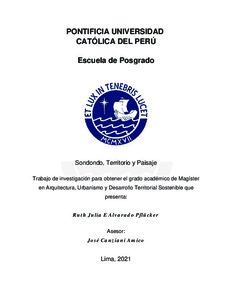| dc.contributor.advisor | Canziani Amico, José | |
| dc.contributor.author | Alvarado Pflücker, Ruth Julia E. | |
| dc.date.accessioned | 2022-01-17T12:10:07Z | |
| dc.date.available | 2022-01-17T12:10:07Z | |
| dc.date.created | 2021 | |
| dc.date.issued | 2022-01-17 | |
| dc.identifier.uri | http://hdl.handle.net/20.500.12404/21297 | |
| dc.description.abstract | La presente investigación propone el análisis territorial de lo que se conoce como el
Valle del Sondondo, ubicado en la provincia de Lucanas, en la región Ayacucho. La
zona de estudio incluye las cuencas hidrográficas de los ríos Negromayo, Mayobamba
y Sondondo, así como las cadenas montañosas que las conforman y las pampas
altoandinas.
La tesis se plantea como una investigación empírica, un análisis geomorfológico del
territorio, cuyo fin es identificar los lugares de referencia o nodos geográficos y las
relaciones visuales que existen y que revelarán las claves sustantivas del lugar. Se busca
lograr el entendimiento espacial y de la escala, identificar las relaciones transversales y
verticales en las cuencas, así como las relaciones espaciales entre poblaciones cercanas
a partir de secciones territoriales. Contempla también la identificación y comprensión
de los centros poblados, la articulación entre ellos y su relación simbiótica con el
paisaje. Las preexistencias —los sitios arqueológicos, los canales y andenes— se
entienden aquí como una variable adicional, parte de la trama que construye el paisaje
cultural.
Finalmente, esta tesis tiene una parte propositiva e intenta aportar unos lineamientos
básicos para el manejo sostenible del territorio con especial atención al tema del
paisaje y al fomento de un ecoturismo sensible con el lugar. Se diseñarán algunas
infraestructuras mínimas, para lugares precisos, que servirán para brindar servicios
elementales, pero, sobre todo, se plantearán como piezas aisladas, en dialogo con
el paisaje y como sutiles articuladoras del territorio. Se trata así, de una propuesta
de intervenciones mínimas, que buscan potenciar la experiencia del recorrido y el
territorio.
El entendimiento del territorio como un palimpsesto, un lienzo conformado por capas
estratificadas que se superponen en el tiempo, nos permite verlo como un constructo
conformado por muchas variables en permanente evolución. Si le sumamos a esto
la dimensión de lo intangible —el mito, el símbolo, lo sagrado— se empieza a
comprender la gran complejidad de este territorio ancestral. | es_ES |
| dc.description.abstract | This research thesis is focused on the territorial analysis of the Sondondo Valley, which
is located in the province of Lucanas, in Ayacucho, in the Andean region of Peru. The
study area includes the basins of the Negromayo, Mayobamba and Sondondo rivers,
as well as the mountain ranges that form the valleys and the high Andean plateaus.
The thesis is proposed as an empirical investigation with the purpose of addressing
a territorial geomorphological analysis that intends to identify the landmarks, the
geographical nodes and the visual connections that exist among riverbanks or
altitudinal levels and that will reveal the clues to help in the comprehension of the
specificity of this place. The objective is to achieve —using territorial sections and
other resources— an understanding of the space and the scale. Also, the thesis
aims to identify the vertical and transversal relations in the basins and the different
ecological levels while recognizing the interactions among the communities. This
research addresses the identification of the singularity of the villages and their unique
characteristics, their synergies and their symbiotic relationship with the surrounding
landscape. The preexistences —the archaeological sites, the terraces and aqueducts—
are understood as another layer of information, as part of the weft that adds value to
the cultural landscape.
Finally, this thesis has a pragmatic aim, and intends to propose basic guidelines for
a sustainable territorial management, with special attention to the landscape while
promoting a site-specific form of ecotourism, that addresses issues of vulnerability in
a context where tourism could be a risk if not managed properly. The design proposal
offers projects for five specific sites, providing small infrastructures to solve basic
needs. Overall, these minimal structures are conceived as territorial articulators. These
“still objects” are subtle interventions, meant as isolated pieces in dialogue with the
surrounding landscape and are meant to integrate the region while they add meaning
to the travel experience.
The notion of the territory as a palimpsest, understood as a canvas with stratified layers
of information built over time, reveals a different view of the territory as an organic
and cultural construct, which is constantly evolving. Another layer for the analysis is
the realm of the intangible: the myths, the symbols and the sacred traditions. The sum
of all these variables, enables the construction of a narrative that speaks of the great
complexity of this ancestral territory. | es_ES |
| dc.language.iso | spa | es_ES |
| dc.publisher | Pontificia Universidad Católica del Perú | es_ES |
| dc.rights | info:eu-repo/semantics/closedAccess | es_ES |
| dc.subject | Territorio--Historia--Perú--Ayacucho | es_ES |
| dc.subject | Espacio en arquitectura--Perú--Ayacucho | es_ES |
| dc.subject | Arquitectura del paisaje--Perú--Ayacucho | es_ES |
| dc.title | Sondondo, Territorio y Paisaje | es_ES |
| dc.type | info:eu-repo/semantics/masterThesis | es_ES |
| thesis.degree.name | Magíster en Arquitectura, Urbanismo y Desarrollo Territorial Sostenible | es_ES |
| thesis.degree.level | Maestría | es_ES |
| thesis.degree.grantor | Pontificia Universidad Católica del Perú. Escuela de Posgrado | es_ES |
| thesis.degree.discipline | Arquitectura, Urbanismo y Desarrollo Territorial Sostenible | es_ES |
| renati.advisor.dni | 06645728 | |
| renati.advisor.orcid | https://orcid.org/0000-0003-0004-4006 | es_ES |
| renati.author.dni | 06634354 | |
| renati.discipline | 731237 | es_ES |
| renati.juror | Sáez Giráldez, Elia | es_ES |
| renati.juror | Canziani Amico, José | es_ES |
| renati.juror | León Angell, María Alexia | es_ES |
| renati.level | https://purl.org/pe-repo/renati/level#maestro | es_ES |
| renati.type | https://purl.org/pe-repo/renati/type#trabajoDeInvestigacion | es_ES |
| dc.publisher.country | PE | es_ES |
| dc.subject.ocde | https://purl.org/pe-repo/ocde/ford#6.04.08 | es_ES |





